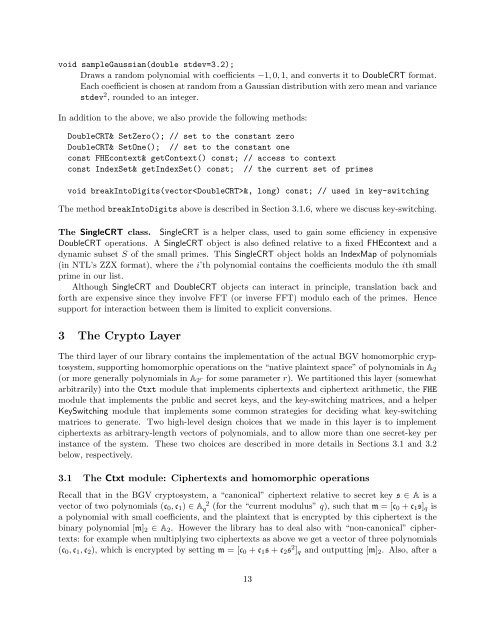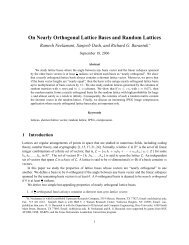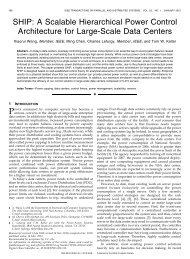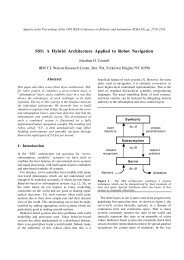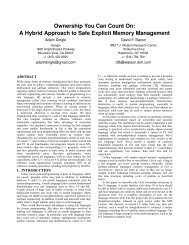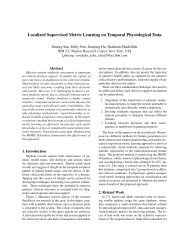Design and Implementation of a Homomorphic ... - Researcher
Design and Implementation of a Homomorphic ... - Researcher
Design and Implementation of a Homomorphic ... - Researcher
You also want an ePaper? Increase the reach of your titles
YUMPU automatically turns print PDFs into web optimized ePapers that Google loves.
void sampleGaussian(double stdev=3.2);<br />
Draws a r<strong>and</strong>om polynomial with coefficients −1, 0, 1, <strong>and</strong> converts it to DoubleCRT format.<br />
Each coefficient is chosen at r<strong>and</strong>om from a Gaussian distribution with zero mean <strong>and</strong> variance<br />
stdev 2 , rounded to an integer.<br />
In addition to the above, we also provide the following methods:<br />
DoubleCRT& SetZero(); // set to the constant zero<br />
DoubleCRT& SetOne(); // set to the constant one<br />
const FHEcontext& getContext() const; // access to context<br />
const IndexSet& getIndexSet() const; // the current set <strong>of</strong> primes<br />
void breakIntoDigits(vector&, long) const; // used in key-switching<br />
The method breakIntoDigits above is described in Section 3.1.6, where we discuss key-switching.<br />
The SingleCRT class. SingleCRT is a helper class, used to gain some efficiency in expensive<br />
DoubleCRT operations. A SingleCRT object is also defined relative to a fixed FHEcontext <strong>and</strong> a<br />
dynamic subset S <strong>of</strong> the small primes. This SingleCRT object holds an IndexMap <strong>of</strong> polynomials<br />
(in NTL’s ZZX format), where the i’th polynomial contains the coefficients modulo the ith small<br />
prime in our list.<br />
Although SingleCRT <strong>and</strong> DoubleCRT objects can interact in principle, translation back <strong>and</strong><br />
forth are expensive since they involve FFT (or inverse FFT) modulo each <strong>of</strong> the primes. Hence<br />
support for interaction between them is limited to explicit conversions.<br />
3 The Crypto Layer<br />
The third layer <strong>of</strong> our library contains the implementation <strong>of</strong> the actual BGV homomorphic cryptosystem,<br />
supporting homomorphic operations on the “native plaintext space” <strong>of</strong> polynomials in A 2<br />
(or more generally polynomials in A 2 r for some parameter r). We partitioned this layer (somewhat<br />
arbitrarily) into the Ctxt module that implements ciphertexts <strong>and</strong> ciphertext arithmetic, the FHE<br />
module that implements the public <strong>and</strong> secret keys, <strong>and</strong> the key-switching matrices, <strong>and</strong> a helper<br />
KeySwitching module that implements some common strategies for deciding what key-switching<br />
matrices to generate. Two high-level design choices that we made in this layer is to implement<br />
ciphertexts as arbitrary-length vectors <strong>of</strong> polynomials, <strong>and</strong> to allow more than one secret-key per<br />
instance <strong>of</strong> the system. These two choices are described in more details in Sections 3.1 <strong>and</strong> 3.2<br />
below, respectively.<br />
3.1 The Ctxt module: Ciphertexts <strong>and</strong> homomorphic operations<br />
Recall that in the BGV cryptosystem, a “canonical” ciphertext relative to secret key s ∈ A is a<br />
vector <strong>of</strong> two polynomials (c 0 , c 1 ) ∈ Aq<br />
2 (for the “current modulus” q), such that m = [c 0 + c 1 s] q is<br />
a polynomial with small coefficients, <strong>and</strong> the plaintext that is encrypted by this ciphertext is the<br />
binary polynomial [m] 2 ∈ A 2 . However the library has to deal also with “non-canonical” ciphertexts:<br />
for example when multiplying two ciphertexts as above we get a vector <strong>of</strong> three polynomials<br />
(c 0 , c 1 , c 2 ), which is encrypted by setting m = [c 0 + c 1 s + c 2 s 2 ] q <strong>and</strong> outputting [m] 2 . Also, after a<br />
13


